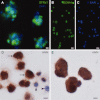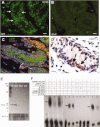ETV5 regulates sertoli cell chemokines involved in mouse stem/progenitor spermatogonia maintenance
- PMID: 20799334
- PMCID: PMC3109872
- DOI: 10.1002/stem.508
ETV5 regulates sertoli cell chemokines involved in mouse stem/progenitor spermatogonia maintenance
Abstract
Spermatogonial stem cells are the only stem cells in the body that transmit genetic information to offspring. Although growth factors responsible for self-renewal of these cells are known, the factors and mechanisms that attract and physically maintain these cells within their microenvironment are poorly understood. Mice with targeted disruption of Ets variant gene 5 (Etv5) show total loss of stem/progenitor spermatogonia following the first wave of spermatogenesis, resulting in a Sertoli cell-only phenotype and aspermia. Microarray analysis of primary Sertoli cells from Etv5 knockout (Etv5(-/-)) versus wild-type (WT) mice revealed significant decreases in expression of several chemokines. Chemotaxis assays demonstrated that migration of stem/progenitor spermatogonia toward Etv5(-/-) Sertoli cells was significantly decreased compared to migration toward WT Sertoli cells. Interestingly, differentiating spermatogonia, spermatocytes, and round spermatids were not chemoattracted by WT Sertoli cells, whereas stem/progenitor spermatogonia showed a high and significant chemotactic index. Rescue assays using recombinant chemokines indicated that C-C-motif ligand 9 (CCL9) facilitates Sertoli cell chemoattraction of stem/progenitor spermatogonia, which express C-C-receptor type 1 (CCR1). In addition, there is protein-DNA interaction between ETV5 and Ccl9, suggesting that ETV5 might be a direct regulator of Ccl9 expression. Taken together, our data show for the first time that Sertoli cells are chemoattractive for stem/progenitor spermatogonia, and that production of specific chemokines is regulated by ETV5. Therefore, changes in chemokine production and consequent decreases in chemoattraction by Etv5(-/-) Sertoli cells helps to explain stem/progenitor spermatogonia loss in Etv5(-/-) mice.
Figures







Similar articles
-
Loss of Gata4 in Sertoli cells impairs the spermatogonial stem cell niche and causes germ cell exhaustion by attenuating chemokine signaling.Oncotarget. 2015 Nov 10;6(35):37012-27. doi: 10.18632/oncotarget.6115. Oncotarget. 2015. PMID: 26473289 Free PMC article.
-
Loss of Etv5 decreases proliferation and RET levels in neonatal mouse testicular germ cells and causes an abnormal first wave of spermatogenesis.Biol Reprod. 2009 Aug;81(2):258-66. doi: 10.1095/biolreprod.108.075200. Epub 2009 Apr 15. Biol Reprod. 2009. PMID: 19369650 Free PMC article.
-
A missense mutation in the transcription factor ETV5 leads to sterility, increased embryonic and perinatal death, postnatal growth restriction, renal asymmetry and polydactyly in the mouse.PLoS One. 2013 Oct 21;8(10):e77311. doi: 10.1371/journal.pone.0077311. eCollection 2013. PLoS One. 2013. PMID: 24204802 Free PMC article.
-
Regulation of spermatogonial stem cell self-renewal and spermatocyte meiosis by Sertoli cell signaling.Reproduction. 2015 Apr;149(4):R159-67. doi: 10.1530/REP-14-0481. Epub 2014 Dec 12. Reproduction. 2015. PMID: 25504872 Review.
-
ETV5 is required for continuous spermatogenesis in adult mice and may mediate blood testes barrier function and testicular immune privilege.Ann N Y Acad Sci. 2007 Dec;1120:144-51. doi: 10.1196/annals.1411.005. Epub 2007 Oct 2. Ann N Y Acad Sci. 2007. PMID: 17911411 Free PMC article. Review.
Cited by
-
Constitutive activation of NOTCH1 signaling in Sertoli cells causes gonocyte exit from quiescence.Dev Biol. 2013 May 1;377(1):188-201. doi: 10.1016/j.ydbio.2013.01.031. Epub 2013 Feb 4. Dev Biol. 2013. PMID: 23391689 Free PMC article.
-
Etv5, a transcription factor with versatile functions in male reproduction.Clin Exp Reprod Med. 2012 Jun;39(2):41-5. doi: 10.5653/cerm.2012.39.2.41. Epub 2012 Jun 30. Clin Exp Reprod Med. 2012. PMID: 22816068 Free PMC article.
-
In vitro chemokine (C-C motif) receptor 6-dependent non-inflammatory chemotaxis during spermatogenesis.Biol Res. 2018 May 22;51(1):12. doi: 10.1186/s40659-018-0161-z. Biol Res. 2018. PMID: 29788995 Free PMC article.
-
Loss of Gata4 in Sertoli cells impairs the spermatogonial stem cell niche and causes germ cell exhaustion by attenuating chemokine signaling.Oncotarget. 2015 Nov 10;6(35):37012-27. doi: 10.18632/oncotarget.6115. Oncotarget. 2015. PMID: 26473289 Free PMC article.
-
Regulation of spermatogonial stem cell self-renewal and proliferation in mammals.Histol Histopathol. 2022 Sep;37(9):825-838. doi: 10.14670/HH-18-461. Epub 2022 Apr 26. Histol Histopathol. 2022. PMID: 35470414 Review.
References
Publication types
MeSH terms
Substances
Grants and funding
LinkOut - more resources
Full Text Sources
Medical

